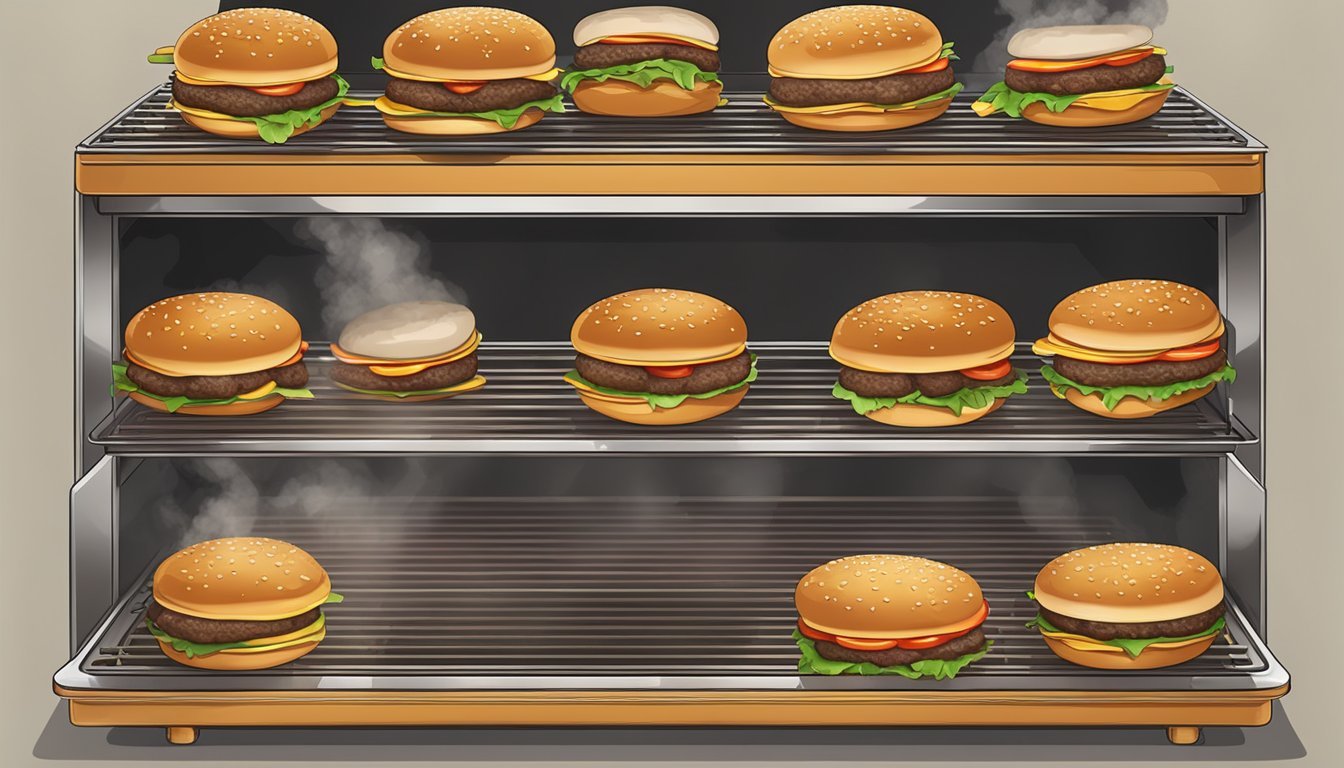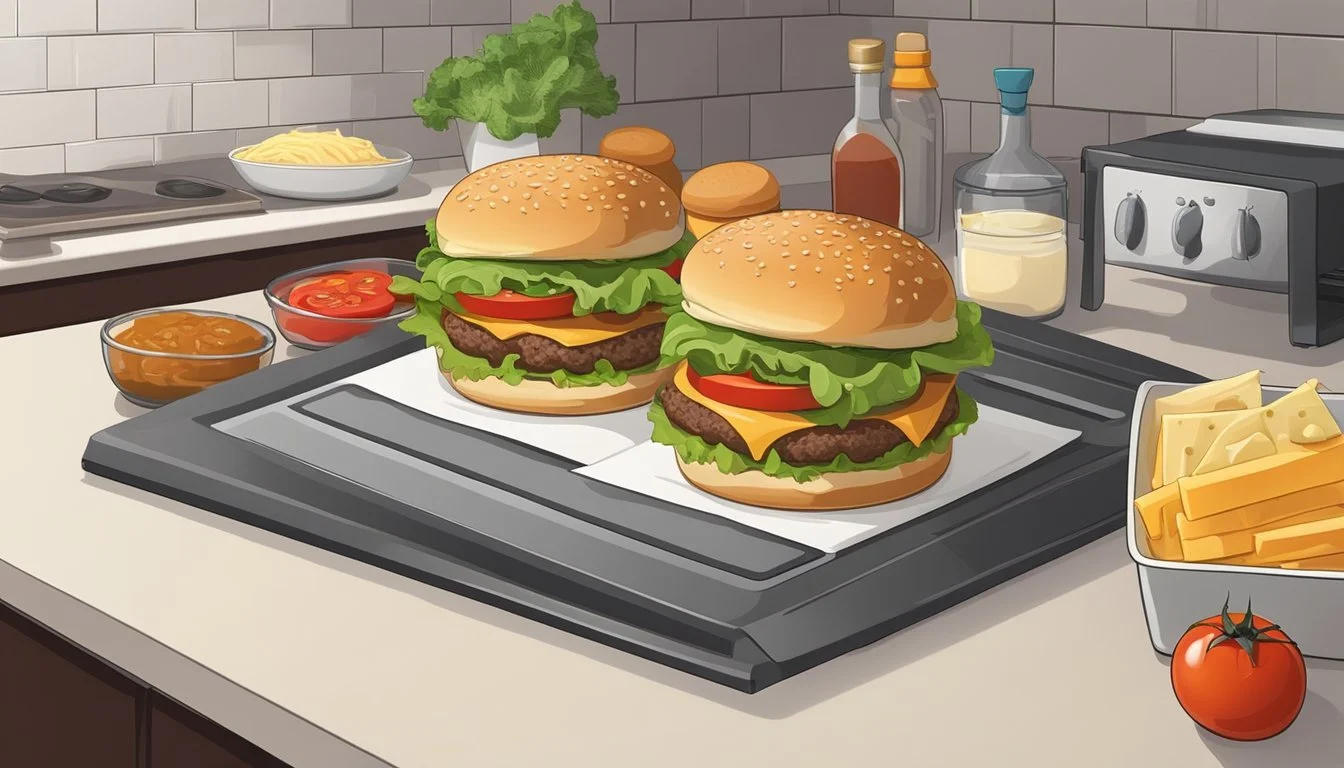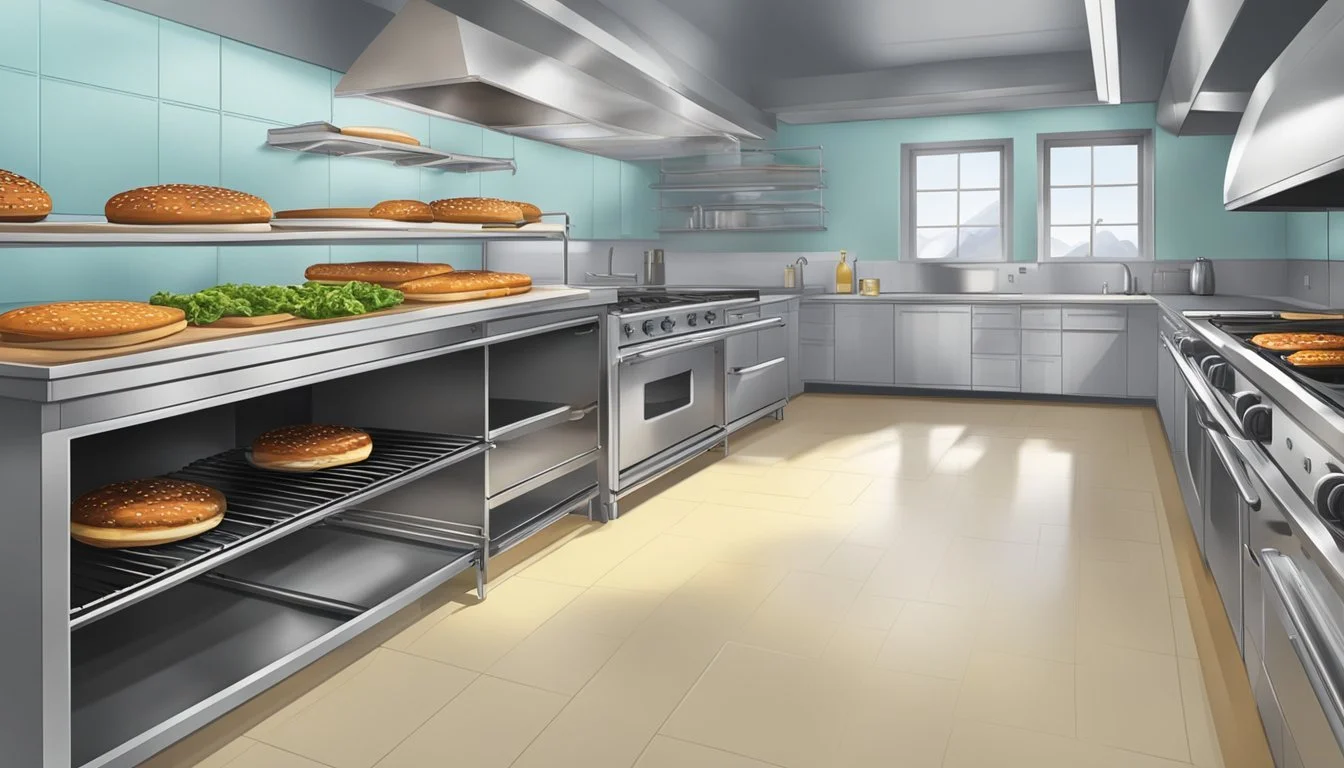How to Cook Burgers in the Oven
Juicy and Delicious Results
Cooking burgers in the oven offers a convenient and delicious alternative to grilling. This method allows for juicy, flavorful patties without the need for outdoor equipment or perfect weather. To bake burgers, preheat the oven to 350°F, form seasoned patties, and cook for 15-20 minutes until they reach an internal temperature of 160°F.
Oven-baked burgers can be customized with various seasonings and toppings to suit individual tastes. Adding cheese during the last few minutes of cooking ensures it melts perfectly over the patty. For an extra layer of flavor, some recipes suggest wrapping the burgers in foil after initial baking and returning them to the oven for a short time.
This indoor cooking technique is ideal for those without access to a grill or for when time is limited. It produces consistently cooked burgers with minimal effort, making it a practical choice for family dinners or casual gatherings. Experimenting with different beef blends, seasonings, and cooking times can help achieve the perfect oven-baked burger tailored to personal preferences.
Choosing the Right Ingredients
Selecting quality ingredients is crucial for creating delicious oven-baked burgers. The right meat, buns, toppings, and seasonings can elevate your burger from good to great.
Selecting the Meat
Ground beef is the foundation of a great burger. Opt for lean ground beef with 80/20 or 85/15 fat content for juicy, flavorful patties. Higher fat percentages can lead to more shrinkage and flare-ups in the oven.
Look for freshly ground beef from a reputable source. If possible, ask the butcher to grind it on the spot. This ensures maximum freshness and flavor.
For a healthier option, consider lean ground turkey or chicken. These alternatives can be just as tasty when seasoned properly.
Buns and Toppings
Choose sturdy hamburger buns that can hold up to juicy patties and toppings. Brioche, potato, or sesame seed buns are excellent choices. Whole wheat buns offer a healthier alternative.
For toppings, select fresh ingredients:
Crisp lettuce leaves
Ripe tomato slices
Thinly sliced onions
Melty cheese (cheddar, Swiss, or American)
Don't forget the condiments:
Ketchup
Mustard
Mayonnaise
Pickles
Seasoning for Flavor
Proper seasoning enhances the natural flavor of the meat. A simple blend of kosher salt and freshly ground black pepper works wonders. For added depth, incorporate:
Garlic powder
Onion powder
Paprika
Worcestershire sauce
Mix the seasonings into the ground beef before forming patties. This ensures even distribution of flavors throughout the burger.
For a smoky flavor, add a pinch of smoked paprika or a few drops of liquid smoke to the meat mixture. Be careful not to overseason, as it can overpower the natural beef flavor.
Preparing the Oven and Cookware
Proper preparation of the oven and cookware is crucial for achieving perfectly cooked burgers. This involves preheating the oven to the correct temperature and selecting the right baking vessel.
Preheating the Oven
Set the oven temperature to 375°F (190°C). This ensures even cooking and helps develop a nice crust on the burgers. Allow 10-15 minutes for the oven to fully preheat before placing the burgers inside.
For crispier burgers, some cooks prefer a higher temperature of 400°F (204°C). Adjust based on personal preference and burger thickness.
Always check that the oven rack is positioned in the middle. This allows for optimal heat circulation around the burgers.
Setting Up the Baking Sheet
A rimmed baking sheet is ideal for cooking burgers in the oven. Line it with aluminum foil or parchment paper for easy cleanup. This also helps prevent sticking.
If using foil, lightly grease it with cooking spray or brush with oil. For parchment paper, no additional greasing is necessary.
Place a wire rack on the baking sheet. This elevates the burgers, allowing hot air to circulate underneath. It also helps drain excess fat.
Choosing the Right Pan
A cast iron skillet is an excellent alternative to a baking sheet. It retains heat well and creates a nice crust on the burgers.
Preheat the cast iron skillet in the oven for about 15 minutes before adding the burgers. This ensures even cooking from the start.
For a non-stick option, use a heavy-duty baking dish. Grease it lightly to prevent sticking. Avoid glass baking dishes, as they can shatter at high temperatures.
Choose a pan size that allows at least 1 inch of space between burgers. This prevents overcrowding and ensures even cooking.
Forming and Seasoning Patties
Properly forming and seasoning burger patties is crucial for achieving juicy, flavorful results when cooking in the oven. The right techniques ensure even cooking and enhance taste.
Molding Patties to Size
Divide ground beef into equal portions, typically 4-6 ounces each for standard burgers. Gently shape the meat into round patties about 3/4 inch thick. Avoid overworking the meat, as this can lead to tough burgers.
Use clean hands or a patty press for consistent size and shape. Make patties slightly larger than the bun, as they will shrink during cooking.
For best results, chill formed patties in the refrigerator for 30 minutes before cooking. This helps them hold their shape better in the oven.
Adding Flavor with Seasonings
Season burger patties generously on both sides. A classic blend includes salt, black pepper, garlic powder, and onion powder. For extra flavor, add paprika or chili powder.
Mix seasonings in a small bowl before applying to ensure even distribution. Use about 1 teaspoon of seasoning mix per patty.
For a simpler approach, just salt and pepper work well. Apply seasoning right before cooking to prevent drawing out moisture from the meat.
Creating the Indent for Even Cooking
Press a small indentation in the center of each patty with your thumb. This prevents the burgers from puffing up during cooking, ensuring even thickness.
The indent should be about 1/4 inch deep and 1 inch wide. This simple step promotes uniform cooking and helps the patties maintain a flat shape.
For thicker patties, make a slightly deeper indent. This technique is especially useful when cooking burgers in the oven, as it helps counteract the tendency for patties to dome up in dry heat.
Cooking Process
Cooking burgers in the oven is a straightforward process that yields juicy, flavorful results. The key steps involve proper baking techniques, checking for doneness, and adding cheese for extra flavor.
Baking the Burgers
Preheat the oven to 375°F (190°C). Place the burger patties on a baking sheet or in a cast-iron skillet. Avoid overcrowding to ensure even cooking. Season the burgers with salt and pepper or your preferred spice blend. Place the baking sheet or skillet in the oven and cook for approximately 20 minutes.
For optimal results, flip the burgers halfway through cooking. This ensures even browning on both sides. If using a cast-iron skillet, be cautious when handling as it will be extremely hot.
Checking for Doneness
Use a meat thermometer to check the internal temperature of the burgers. Insert it into the thickest part of the patty. For medium-rare, aim for 135°F (57°C). Medium burgers should reach 140°F (60°C), while well-done burgers need to hit 160°F (71°C).
If a thermometer is unavailable, visual cues can help. A medium burger will have a pink center, while well-done burgers will be brown throughout. Cooking times may vary depending on the thickness of the patties and oven performance.
Adding Cheese to Burgers
To add cheese, place a slice on top of each burger during the last 2-3 minutes of cooking. American cheese melts easily and is a popular choice. Other options include cheddar, Swiss, or provolone.
For a more melted cheese experience, cover the baking sheet with aluminum foil after adding the cheese. This traps heat and helps melt the cheese more quickly.
Allow the burgers to rest for a few minutes after removing them from the oven. This helps the juices redistribute, resulting in a more flavorful and juicy burger.
Serving and Presentation
The final steps of preparing oven-baked burgers involve careful attention to bun preparation, burger assembly, and selection of complementary sides. These elements elevate the dining experience and complete the meal.
Toasting the Buns
Toasted buns add texture and warmth to burgers. Place buns cut-side up on a baking sheet. Brush lightly with melted butter for extra flavor. Toast in the oven for 2-3 minutes until golden brown.
For a crispy exterior and soft interior, use the broiler setting. Watch closely to prevent burning. Alternatively, toast buns in a skillet over medium heat for 1-2 minutes per side.
Toasted buns provide a satisfying crunch and help prevent sogginess from burger juices.
Assembling the Burgers
Start with the bottom bun. Add a layer of lettuce to act as a barrier against juices. Place the cooked patty on top. Add cheese if desired, allowing residual heat to melt it slightly.
Layer on toppings like sliced tomatoes, onions, or pickles. Apply condiments such as ketchup, mustard, or mayonnaise to the top bun. Place the top bun on the stack.
For a cohesive burger, insert a toothpick through the center. This keeps layers intact and makes eating easier.
Sides and Accompaniments
Classic sides include french fries or potato wedges. Bake these alongside the burgers for convenience. Sweet potato fries offer a healthier alternative with a touch of sweetness.
For a lighter option, serve a crisp green salad or coleslaw. These provide a refreshing contrast to the rich burger.
Consider offering a variety of additional toppings and condiments. Sliced avocado, bacon, or sautéed mushrooms allow for customization. Specialty sauces like garlic aioli or chipotle mayo add gourmet flair.
Pickles, jalapeños, or pepperoncini on the side cater to those who enjoy extra tang or heat with their burgers.
Clean-up and Storage
Proper clean-up and storage practices ensure a tidy kitchen and safe consumption of leftover burgers. These steps help maintain food quality and prevent waste.
Easy Clean-up Tips
Use aluminum foil or parchment paper to line baking sheets before cooking burgers in the oven. This simple step significantly reduces cleanup time and effort.
Remove any excess grease from cooled pans with paper towels before washing. Soak stubborn residue in warm, soapy water for easier removal.
For baking racks, scrub with a stiff brush to remove stuck-on particles. Dishwasher-safe racks can be placed directly in the machine for thorough cleaning.
Wipe down oven surfaces with a damp cloth after they've cooled to prevent buildup of grease and food particles.
Storing Leftover Burgers
Allow cooked burgers to cool to room temperature before storage. This prevents condensation and bacterial growth.
Wrap individual burgers tightly in plastic wrap or aluminum foil. Place wrapped burgers in an airtight container or resealable plastic bag.
Store leftover burgers in the refrigerator for up to 3-4 days. For longer storage, freeze burgers for up to 3 months.
Label containers with the date of preparation to track freshness. When reheating, ensure burgers reach an internal temperature of 165°F (74°C) for food safety.
Separate burger patties from buns during storage to prevent sogginess. Reheat buns separately for best texture.
Additional Tips and Variations
Exploring different cooking methods, dietary options, and flavor profiles can elevate your oven-baked burger experience. These variations cater to diverse preferences and dietary needs while maintaining the delicious essence of a classic burger.
Alternative Cooking Methods
Broiling offers a quick alternative to baking burgers. Place patties on a broiling pan and cook 3-4 inches from the heat source for about 5 minutes per side. For a crispy exterior, try pan-searing burgers in a cast-iron skillet for 2-3 minutes before finishing in the oven. This method combines stovetop and oven cooking for optimal texture.
Air fryers provide another option. Cook burgers at 375°F for 10-12 minutes, flipping halfway through. This method yields a crispy exterior while keeping the inside juicy.
Healthy and Dietary Options
Turkey burgers serve as a leaner alternative to beef. Mix ground turkey with breadcrumbs, egg, and seasonings for moisture and flavor. Cook at 375°F for 20-25 minutes.
Vegetarian options include black bean burgers or portobello mushroom caps. For black bean burgers, mash beans with breadcrumbs, spices, and a binder like egg or flax. Bake at 375°F for 15-20 minutes.
Low-carb options involve using lettuce wraps instead of buns. Choose large, sturdy leaves like iceberg or romaine.
Exploring Different Flavors
Infuse burgers with various seasonings to create unique flavor profiles. Try mixing in minced garlic, grated cheese, or chopped herbs like basil or cilantro. Worcestershire sauce or soy sauce can add depth.
Experiment with different cheese toppings. Blue cheese crumbles, pepper jack, or smoked gouda offer distinct flavors. Add cheese during the last few minutes of baking.
Toppings can transform a burger. Consider caramelized onions, sautéed mushrooms, or crispy bacon. For a gourmet touch, try avocado slices or a fried egg.




